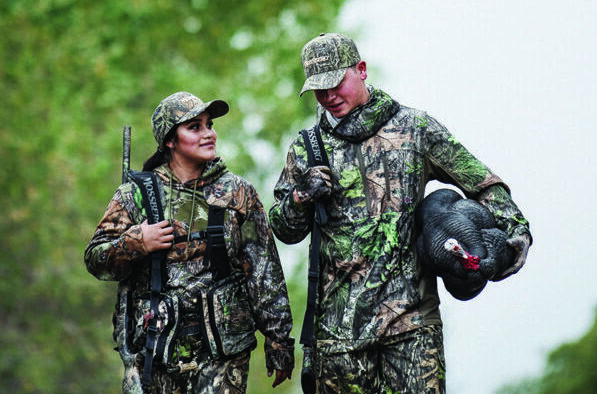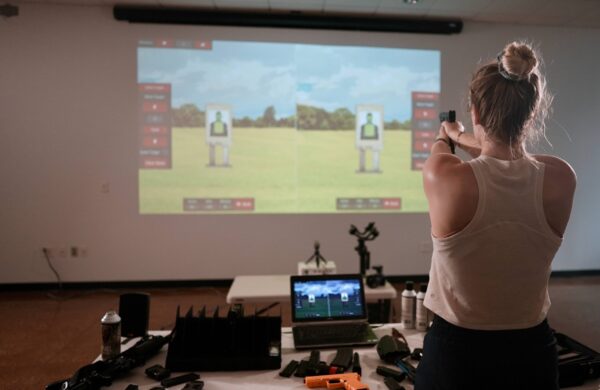Marketing To The Turkey Hunter
White-tailed deer may be, overall, the most widely hunted big-game animals in North America. But when it comes to hunter fanaticism, it often centers on the pursuit of feathers — turkey feathers.
In an evolving world where tools and technology are letting hunters be successful with longer shots, the turkey hunting experience — at its essence — mostly remains up close and personal. Few things hook a hunter more than learning how to use the right call to strike up a dialogue with a fired-up gobbler and then feeling adrenaline pump when that longbeard gobbles so close and urgently, the overhead leaves seem to shudder and shed morning dew.
Turkey hunting, like deer hunting, used to be a mostly spartan endeavor, but manufacturers have increasingly innovated to create products designed to help hunters be more successful and more comfortable. Lifelike decoys, red dot optics on specialized shotguns, portable blinds, comfy low-profile seats, amped-up ammo and seasonally appropriate camo are all in play.
Marketing to North America’s legions of turkey aficionados is all about timing and understanding the customer. Two successful retailers share their thoughts on closing the deal with the gobbler getters.
“We always try to carry the ‘new hotness’ from the major manufacturers knowing those items will be the ones advertising dollars are spent on each year.”
Brad Stephenson, Turkey Expert
Green Top Sporting Goods • Ashland, Va.
Ammo Innovation Driving Change
Green Top Sporting Goods in Ashland, Va., is in the heart of the eastern wild turkey habitat. The National Wild Turkey Federation was founded in Fredericksburg, just 45 minutes north, in 1973.
Brad Stephenson is Green Top’s in-house turkey expert. He credits ammunition innovations with driving a 180-degree shift in turkey hunting firearms from a generation ago.
“When I got into turkey hunting, most people were using their standard field shotgun with 2.75″ or 3″ Hi-Brass lead No. 5s or 4s and a factory full choke,” Stephenson said. “As people wanted more pellets and more range, 10 GA ‘turkey guns’ came about, and the 12 GA 3.5″ chamber really came to the forefront as people were looking for 10 GA payloads in a gun that could also shoot standard length, 12 GA shells in other circumstances.”
This seminal market shift signaled the advent of specialization, with “extra-full chokes, shorter barrels, camo dips, high-viz sights, rifle sights, red dot, etc.,” he observed. “Most of these improvements were geared to bigger, better, farther,” he added.
Stephenson said the TSS (tungsten super shot) ammo revolution has stretched the turkey hunting market, with the energy yielded by such small pellets making previously sub-gauge guns like the .410- and 28 GA viable turkey killers at standard ranges out to 40 yards.
“There’s been a huge swing in the mindset of many turkey hunters from bigger and farther to comfortable, convenient and fun,” Stephenson reasoned. “These little sub-gauge guns are so much smaller and lighter they are a joy to tote around all morning, are a lot easier to hold up for extended periods while waiting for a tom to close those last yards and are great for getting women and children into turkey hunting with the reduced recoil.”
Not Just One Type Of Hunter
Rees Vail, vice president of Fin Feather Fur Outfitters, a six-store chain in northern Ohio, says decoys offer additional examples of how things have evolved.
“The old Feather Flex $6 foam decoy we had back in the day has transitioned to the ultra-realistic models of today, costing up to $200. Things have evolved,” Vail said. “You can spend $2,000–$3,000 to shoot a 20-lb. turkey.”
In a sense, the evolution isn’t much different than what was seen in the deer hunting market a couple of decades earlier. Many hunters of old owned one rifle and had one set of red or green wool pants and jacket. A box of .30-06 shells would last a few years.
Contrast that mid-20th century vision with today. Stephenson believes there are as many types of “turkey customers” as there are types of people.
“We see them all,” he stated. “There’s the guy using the same camo and call his grandpa gave him in the ’70s who just needs 10 more shells. There’s the guy who has everything he needs, but still just has to see what’s new. There’s the novice who has never been hunting, but saw something cool online and wants to try it. Then, there’s the guy who is an experienced hunter, but not of turkeys, and now he’s looking to expand.”
“The marketing definitely gets people to come to the stores — gets them thinking about what they have or don’t have in their turkey vest.”
Res Vail, Vice President
Fin Feather Fur Outfitters • Youngstown, Ohio.
When To Buy, Promote
At Green Top, the turkey market comprises a small portion of the big store’s overall business, but Stephenson contends chasing the wily birds is an “integral part of our hunting culture.” It’s why the store puts a premium on supporting the turkey hunting customer.
“We place our spring turkey hunting orders in the fall, hoping for product to start arriving in January,” he said. “With supply chains being what they are, most turkey products arrive in February and March. Our inventory of turkey gear explodes when these big orders start rolling in the back door.”
Green Top begins launching promotions featuring select turkey gear in March and continues through the season opener in early April.
“Consumer demand sees a noticeable uptick in March as those who don’t want to be without begin hunting down whatever gear they want for the upcoming season,” Stephenson explained, “but most turkey hunters are like many other hunters out there and there’s always a mad rush during the last week before the season begins.”
Success, or lack thereof, also breeds sales. Hunters struggling to get a bird often seek out new calls or decoys, he added.
Vail said Fin Feather Fur Outfitters maintains an extensive, direct-mail subscriber list and they’ll fill spring inboxes with targeted turkey hunting email blasts.
“A month-long ad also has multiple pages of turkey-specific items,” he added. “The marketing definitely gets people to come to the stores — gets them thinking about what they have or don’t have in their turkey vest.”
Fin Feature Fur’s assortment spans vests to blinds, ammo, calls, decoys and camo, with many major brands represented, including Benelli, Browning, Sitka, Rocky, Lacrosse, Alps and Avian-X.
Mostly Informed/Influenced Consumers
Vail is mindful not all gear is appropriate for all turkey hunters. Helping a new hunter, for example, pick the right latex mouth call for his or her experience level, is important.
“Most turkey hunters, unless they’re new, don’t need a lot of attention or assistance,” he contends. “They know what they can handle or need. A new person might need advice, especially when it comes to things like calls and helping them make an appropriate selection for a mouth call. The same with selecting the right choke tube for a shotgun.”
Stephenson noted a challenge facing his store is staying up on which brands have the biggest presence in the market.
“The companies making turkey hunting products do their best to influence customers to try their products,” he said. “Our main challenge is to figure out which companies have been successful in reaching customers, what the customer is going to come to the store looking for and then to make sure we have enough of the correct products.”
Green Top’s spring assortment is robust, according to Stephenson. It includes turkey-specific shotguns from most major manufacturers. These guns are usually fully camouflaged, have shorter barrels with extended, extra-full turkey chokes, high-visibility sights or are optics-ready or equipped.
New TSS ammo is revolutionizing the game, but many consumers can’t (or don’t want to) spend about $10 a shell, so turkey ammunition offerings range from economy lead-shot loads, to loads that pattern tighter and farther like Winchester’s Longbeard XR, Federal’s Premium Flight-Control shells or HEVI-Shot’s Magnum Blend.
Then there are accessories. Green Top carries call holsters, “lounger” seats, skirt-type ground blinds and pop-up blinds, including some spacious models that are invaluable when taking disabled persons, kids or the family hunting together.
Decoy options range from inexpensive flex-foam models to taxidermy-quality decoys like the ones from Avian-X and Dave Smith.
“While traditional hen and jake decoys are still the top sellers, we carry 1/4-strut, 1/2-strut and full-strut decoys, as well as the ‘reaping’ strutter decoys meant to be crawled behind,” Stephenson informed. “All of these have become very popular in recent years.”
The sheer volume of commercially made turkey calls on the market is staggering; not to mention the thousands of independent call makers around the country.
“We always try to carry the ‘new hotness’ from the major manufacturers knowing those items will be the ones advertising dollars are spent on each year,” Stephenson said.
Spring Into Action
Many states have fall turkey seasons, but hunter enthusiasm is considerably lower than the spring gobbler phenomenon.
Green Top carries some turkey items for the fall hunter, but nowhere near the scale of the spring plus-up. Vail says his outfit is similar, with fall turkeys often taken as a target of opportunity while deer hunting. Spring, though, gets the juices flowing.
“After a long winter, Ohio outdoorsmen and women are ready for spring,” Vail shared. “Everyone wants to get their fishing gear out, go find mushrooms and get ready for turkey season. It’s when they look at their turkey vest and realize they need to replace some mouth calls or lost gear.”
Reaching Green Top customers involves a triple-threat approach involving marketing strategy, targeted advertising and social media information and engagement.
“This is certainly how you reach most folks to let them know what gear you carry, and to remind them the season is approaching, but our experienced sales staff is how we really connect with the customer,” Stephenson said. “We have a lot of salespeople who are avid turkey hunters, myself included. When a customer comes in looking for information or help with turkey hunting, they’re referred to the experienced staff by our non-turkey hunting salespeople. One-on-one is where we can really help someone.”
According to Vail, the consumer market for outdoor gear in general and the turkey hunter in specific varies when it comes to motivation and the type of gear customers want or need, and their receptiveness to marketing and new products.
Basically, some people are brand loyalists, brand reliant, he explained: “I think this applies to hunting in general. Some people don’t just own a cooler, they own a Yeti; the same with Sitka apparel.”
Figuring out the customer’s motivations or allegiances can help drive sales.
Capitalize On Communication Clutter
The deluge of online information is influencing buyer decisions. Stephenson says most customers are watching YouTube videos, looking at social media or surfing the web. Some still read magazines or watch hunting channels on traditional satellite or cable television.
Green Top produces its own material for online consumption, including podcasts and videos, along with blogs. Fin Feather Fur Outfitters is following suit, seeking to ramp up content for its YouTube channel and increasing blog content.
Rees sometimes worries about losing the next generation to the competing crush of things internet related. Such concerns are why retailers like Green Top and Fin Feather Fur have special events designed to get families to the stores and outdoors. Green Top has a multi-day outdoor expo with loads of activities for youngsters and Fin Feather Fur stages an annual a Kids’ Day at a conservation farm.
Still, having an immense volume of content available across ever-increasing media and communication platforms is the cliché “new norm.” Figuring out how to use it to your retailing advantage is essential. In-store “a-ha” moments related to new features and capabilities are increasingly slim with today’s savvy turkey hunting consumer.
“While our salesmen are happy to show and explain new features to customers, most customers come into the store with knowledge of these new products from hunting videos and other hunting media,” Stephenson confirmed. “It’s not hard to sell them on the concept, it’s just a matter of finding the right product at the right price for them.”






